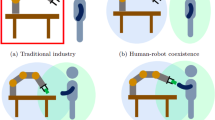Abstract
This paper presents a complete solution for the integration of robots and wireless sensor networks in an ambient intelligence scenario. The basic idea consists in shifting from the paradigm of a very skilled robot interacting with standard objects to a simpler robot able to communicate with smart objects, i.e., objects capable of interacting among themselves and with the robots. A smart object is a standard item equipped with a wireless sensor node (or mote) that provides sensing, communication, and computational capabilities. The mote’s memory is preloaded with object information, as name, size, and visual descriptors of the object. In this paper, we will show how the orthogonal advantages of wireless sensor network technology and of mobile robots can be synergically combined in our approach. We detail the design and the implementation of the interaction of the robot with the smart objects in the environment. Our approach encompasses three main phases: (a) discovery, the robot discovers the smart objects in the area by using wireless communication; (b) mapping, the robot moving in the environment roughly maps the objects in space using wireless communication; (c) recognition, the robot recognizes and precisely locates the smart object of interest by requiring the object to transmit its visual appearance. Hence, the robot matches this appearance with its visual perception and reach the object for fine-grain interaction. Experimental validation for each of the three phases in a real environment is presented.









Similar content being viewed by others
References
Lee J, Hashimoto H (2002) Intelligent space - concept and contents. Adv Robot 16(3):265–280
Kim J, Kim Y, Lee K (2004) The third generation of robotics: ubiquitous robot. In: Proc of the 2nd int conf on autonomous robots and agents, Palmerston North, New Zealand
Dressler F (2006) Self-organization in autonomous sensor and actuator networks. In: Proceedings of the 19th IEEE int conf on architecture of computing systems
Saffiotti A, Broxvall M, Gritti M, LeBlanc K, Lundh R, Rashid J, Seo B, Cho Y (2008) The peis-ecology project: vision and results. In: IROS 2008: intelligent robots and systems. North-Holland Publishing Co., Amsterdam, The Netherlands, The Netherlands, pp 2329–2335
Zanca G, Zorzi F, Zanella A, Zorzi M (2008) Experimental comparison of rssi-based localization algorithms for indoor wireless sensor networks. In: REALWSN ’08: proceedings of the workshop on real-world wireless sensor networks. ACM, New York, NY, USA, pp 1–5
Viola P, Jones M (2001) Robust real-time object detection. In: Second international workshop on statistical and computational theories of vision
Lowe DG (2004) Distinctive image features from scale-invariant keypoints. Int J Comput Vis 60:91–110
Sivic J, ZA (2003) Video google: a text retrieval approach to object matching in videos. In: Proceedings of the international conference on computer vision
Nister D, Stewenius H (2006) Scalable recognition with a vocabulary tree. In: Proceedings of the ieee computer society conference on computer vision and pattern recognition
Philbin J, Chum O, Isard M, Sivic J, Zisserman A (2007) Object retrieval with large vocabularies and fast spatial matching. In: Proceedings of the IEEE computer society conference on computer vision and pattern recognition
Meger D, Forssén P, Lai K, Helmer S, McCann S, Southey T, Baumann M, Little J, Lowe D, Dow B (2007) Curious george: an attentive semantic robot. In: IROS 2007 workshop: from sensors to human spatial concepts
Pretto A, Menegatti E, Pagello E (2007) Reliable features matching for humanoid robots. In: 7th IEEE-RAS international conference on humanoid robots, 2007, pp 532–538
Menegatti E, Zanella A, Zilli S, Zorzi F, Pagello E (2009) Range-only slam with a mobile robot and a wireless sensor networks. In: IEEE international conference on robotics and automation, 2009. ICRA ’09, pp 8–14
Menegatti E, Danieletto M, Mina M, Pretto A, Bardella A, Zanella A, Zanuttigh P (2010) Discovery, localization and recognition of smart objects by a mobile robot. In: Simulation, modeling, and programming for autonomous robots. Lecture notes in computer science, vol 6472. Springer, Berlin, Heidelberg, pp 436–448
Schenato L, Fiorentin F (2009) Average timesync: a consensus-based protocol for time synchronization in wireless sensor networks. In: Proceedings of 1st IFAC workshop on estimation and control of networked systems (NecSys09)
Dutta P, Culler D (2008) Practical asynchronous neighbor discovery and rendezvous for mobile sensing applications. In: SenSys ’08: proceedings of the 6th ACM conference on embedded network sensor systems. ACM, New York, NY, USA, pp 71–84
Zanella A, Menegatti E, Lazzaretto L (2007) Self localization of wireless sensor nodes by means of autonomous mobile robots. In: Proceedings of the 19th Tyrrhenian international workshop on digital communications, Ischia, Italy, 9–12 Sept 2007
Menegatti E, Danieletto M, Mina M, Pretto A, Bardella A, Zanconato S, Zanuttigh P, Zanella A (2010) Autonomous discovery, localization and recognition of smart objects through wsn and image features. In: IEEE international workshop towards SmArt communications and network technologies applied on autonomous systems (SaCoNAS), Miami, USA
Costa JA, Patwari N, Hero III AO (2006) Distributed weighted-multidimensional scaling for node localization in sensor networks. ACM Trans Sens Netw 2:39–64
Goldsmith A (2005) Wireless communications. Cambridge University Press, New York, NY, USA
Bardella A, Bui N, Zanella A, Zorzi M (2010) An experimental study on ieee 802.15.4 multichannel transmission to improve rssi-based service performance. In: Fourth workshop on real-world wireless sensor networks (REALWSN 2010), Colombo, Sri Lanka
Pretto A, Menegatti E, Bennewitz M, Burgard W, Pagello E (2009) A visual odometry framework robust to motion blur. In: IEEE international conference on robotics and automation, 2009. ICRA ’09, pp 2250–2257
Hartley RI, Zisserman A (2004) Multiple view geometry in computer vision, 2nd edn. Cambridge University Press, Cambridge. ISBN: 0521540518
Fischler MA, Bolles RC (1981) Random sample consensus: a paradigm for model fitting with applications to image analysis and automated cartography. Commun ACM 24(6):381–395
Author information
Authors and Affiliations
Corresponding author
Rights and permissions
About this article
Cite this article
Bardella, A., Danieletto, M., Menegatti, E. et al. Autonomous robot exploration in smart environments exploiting wireless sensors and visual features. Ann. Telecommun. 67, 297–311 (2012). https://doi.org/10.1007/s12243-012-0305-z
Received:
Accepted:
Published:
Issue Date:
DOI: https://doi.org/10.1007/s12243-012-0305-z




